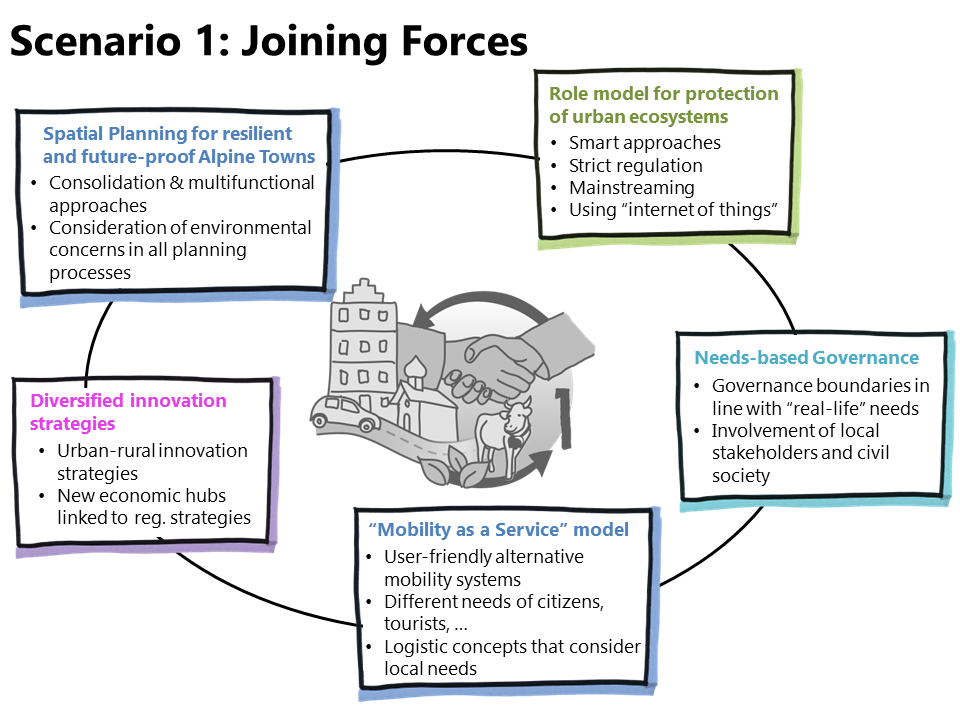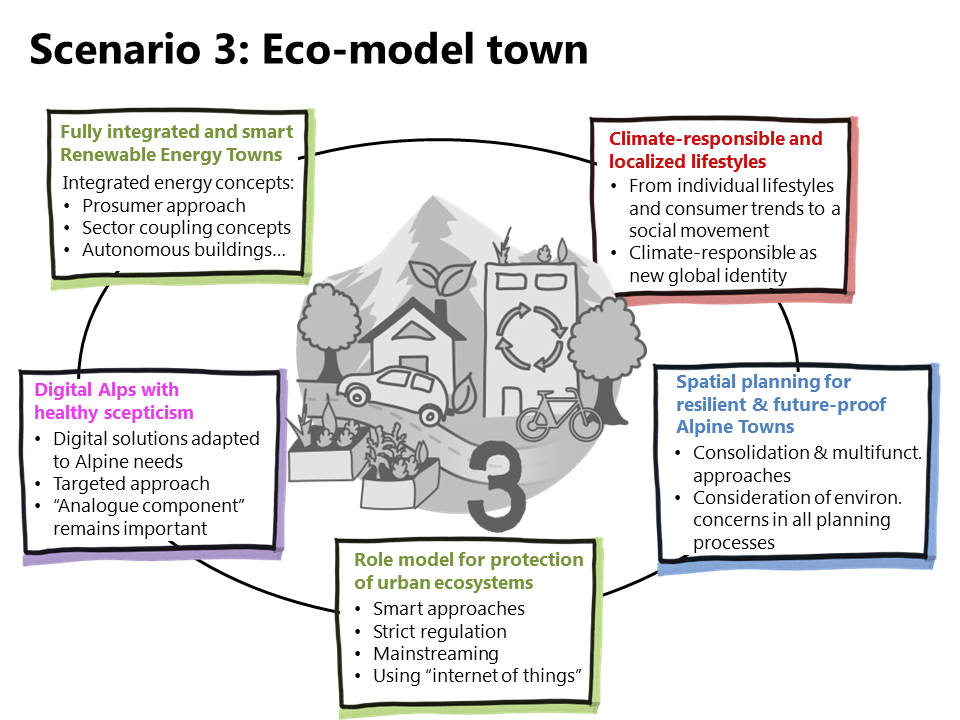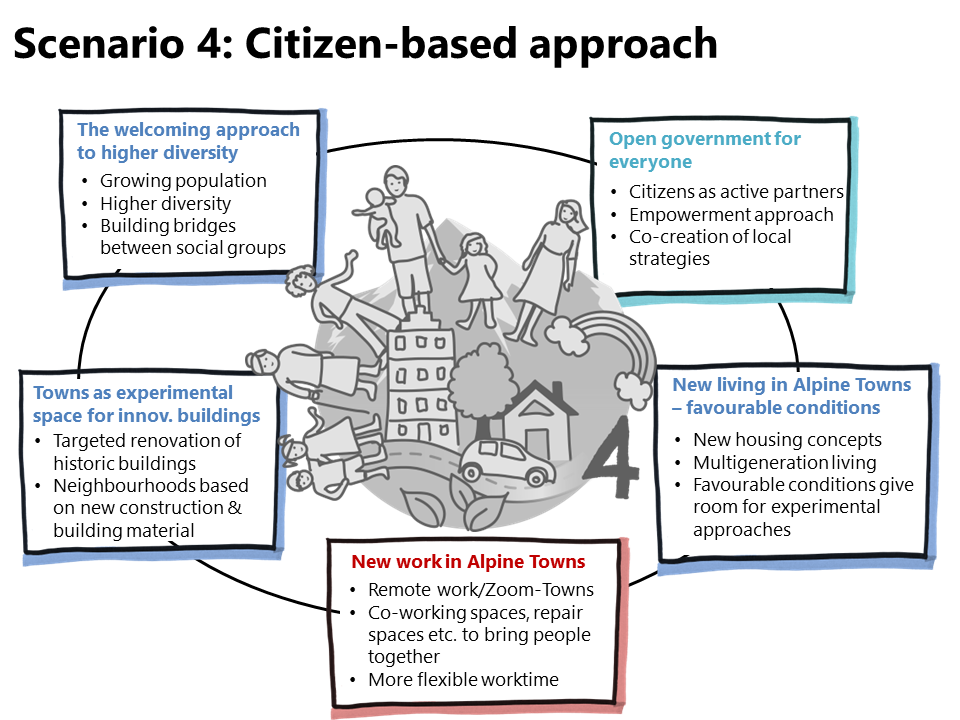OVERVIEW
What role can Alpine towns play in sustainable territorial development? This question is closely linked to future trends and the anticipation of transformation processes. Consequently, the RSA9 includes a forward-looking view, developed in a participatory scenario process that involved experts from various fields. Its goal is to provide a balanced outlook on how Alpine towns could develop until 2050.
The result is five scenarios that illustrate potential future developments. They include not only positive but also several critical developments. Not every scenario might fit each Alpine town: They should be seen as a menu from which a town can pick whatever elements fit best to its specific situation. Such customised pictures of the future provide Alpine towns with a guide to make strategic decisions that are robust to a range of possible future outcomes.
SCENARIO 1: JOINING FORCES
Alpine towns are embedded in urban-rural partnerships. Collaboration is at the heart of this scenario. Towns have realised that future challenges have become increasingly complex and need to be coordinated over larger areas and in partnerships. Regions implement functional approaches that reflect ‘real-life’ rather than spatial, administrative or political boundaries. Governance and spatial planning go hand in hand and tackle major challenges pro-actively. Towns make use of pilot activities and cooperation formats.
Where the urban-rural partnership effectively aligns innovation policies with current challenges and clear, shared goals, it leads to a ‘progressive and coordinated province’. In this scenario, a common vision to guide spatial development processes is of particular interest. A coordinated management of both environmental protection and public services support the efforts.
SCENARIO 2: HIGH-RISK / HIGH-REWARD
The search for economic well-being results in a low resilience to tipping points. In this scenario, Alpine towns have taken a high-risk strategic approach that fully focuses on further developing economic strengths in order to maximise local well-being. This strategy was launched to recover from unfavourable demographic and economic developments and centers around specific potentials of Alpine towns such as ‘amenity migration’, tourism and attracting wealthy people.
In the short term, it proves to be an economically successful approach. However, the strategy risks creating social tensions by increasing the imbalances between winners and losers, especially where it is hampered by external forces. The focus on the strongest potentials acts as stabiliser but ecological ambitions are isolated while the economy concentrates around the ‘strengths’. This creates vulnerability to tipping points and leaves uncertainty for the adaption to future developments.
SCENARIO 3: ECO-MODEL TOWN
Alpine towns decide on a ‘forward escape’ strategy by taking serious climate action. Impacts of a deteriorating environmental condition have become visible throughout the strongly affected Alpine region. Towns and cities improve their resilience by drawing together Alpine-specific expertise and state-of-the-art knowledge. At the same time, Alpine towns are able to turn economic threats resulting from climate change into opportunities, for example by becoming leaders in green economy.
In this frontrunner approach, towns recognise that serious climate action goes beyond technological innovations and requires new approaches regarding lifestyles and consumption patterns as well. Cooperation, cross-sectoral measures and bold political and governance action are key. Digitalisation, eco-friendly business opportunities and a change of lifestyle create positive outcomes in the long term.
SCENARIO 4: CITIZEN-BASED APPROACH
An inclusive approach builds bridges. Alpine towns follow a strong social focus that leads to new lifestyles and a higher awareness of human-environment interactions. It starts with the assumption that Alpine towns will experience a strong population shift, with a tendency towards population growth and a much higher diversity. Instead of focusing on one-dimensional progress and rejecting new influences, this scenario assumes an inclusive approach.
Alpine towns use the growing population and increasing diversity as an opportunity to create a new image, an innovative economy and local identity based on a strong citizen involvement. Sharing responsibilities leads to spill over effects advancing environmental protection. New economic potentials and ways of living that stem from bottom-up approaches will help to transform urban life. But targeted policy-making will be key to ensure positive outcomes for everyone.
SCENARIO 5: EMERGENCY BREAK
Towns put strong regulation and protection in place to maintain a good quality of life. In this scenario, unsustainable lifestyles and economic patterns have led to an accelerated environmental degradation and overshoot of Alpine carrying capacities. Climate change has increased resource conflicts and challenges economic and social structures. Population growth, an ever-rising share of individual mobility and tourism demand has brought Alpine towns to their limits.
The looming tipping points have forced towns to pull the ‘emergency brake’ to preserve a good quality of life for citizens and to avoid further and irreversible damage to the Alpine ecosystems. Strict regulatory approaches based on command-and-control mechanisms are established. Technologically driven transition processes and changes in lifestyles were necessary. The strong regulation affects the economic and governance structure of towns and inhibits development opportunities and social cohesion.




